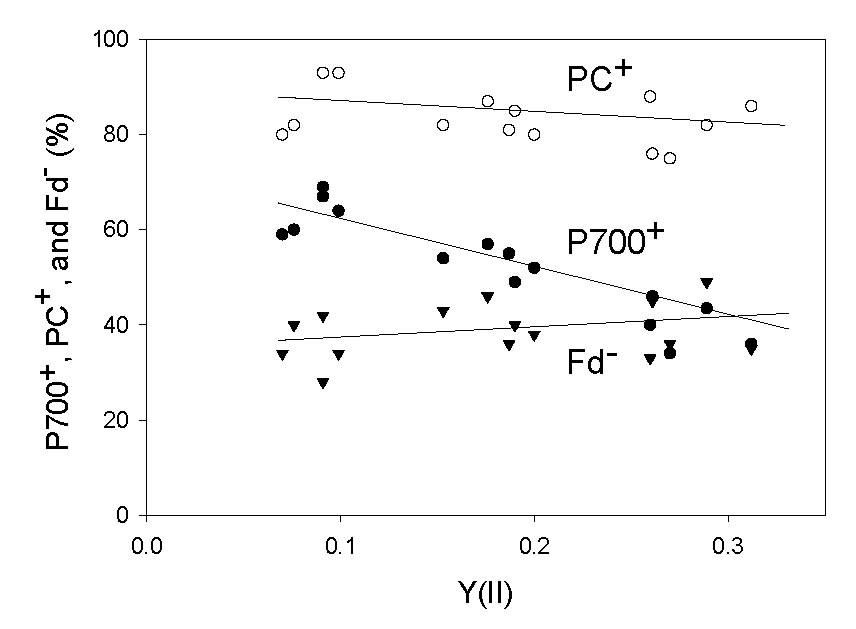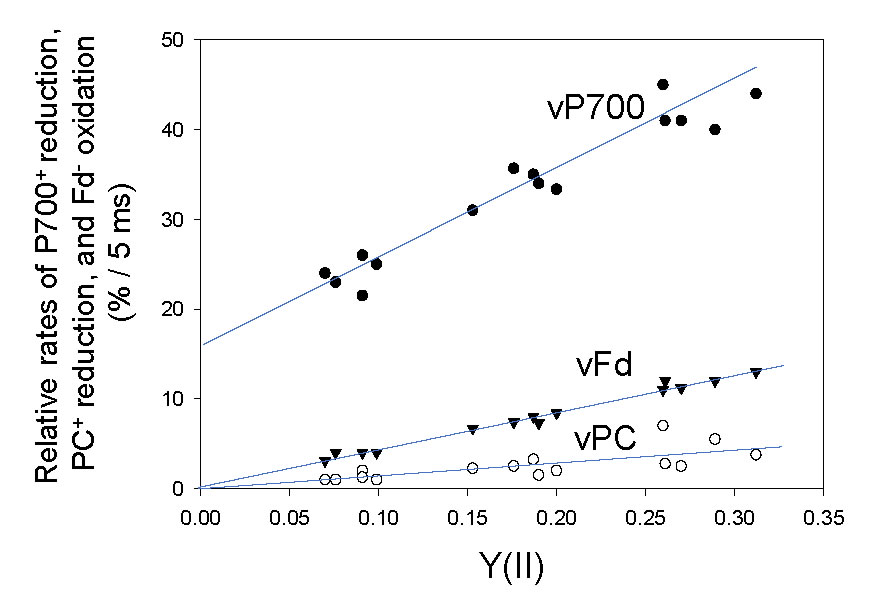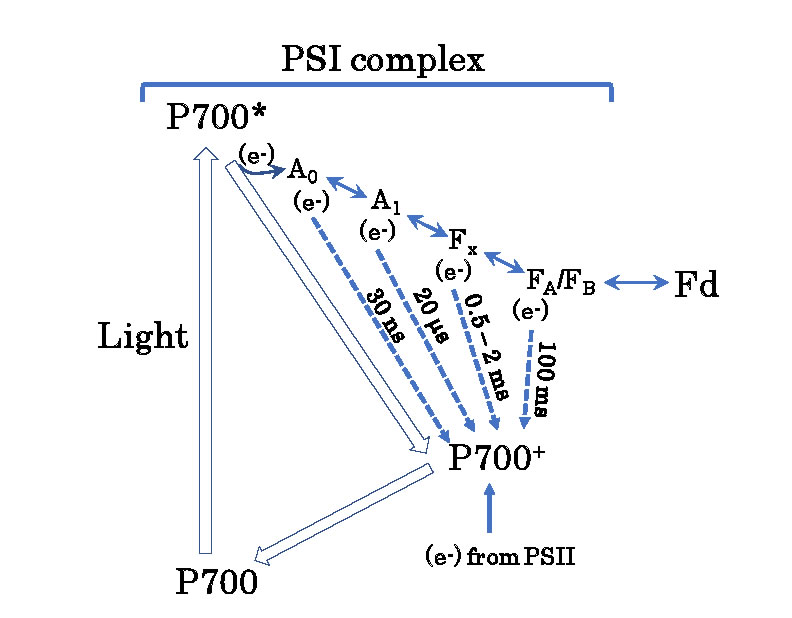Oxygenated photosynthetic organisms can inhibit the production of reactive oxygen species through the oxidation photosystem I (PSI) reaction center chlorophyll P700. Oxidation of P700 is accompanied by the appearance of an electron flow branch (AEF-1) in PSI, which is ineffective for photosynthetic linear electron flow (LEF). To characterize AEF-1, we compared the redox reactions of P700 and ferredoxin (Fd) during the induction of carbon dioxide (CO2) assimilation in wheat leaves by measuring dark-frame relaxation kinetics. Under the ambient CO 2 partial pressure of 40 Pa and the ambient O 2 partial pressure of 21 kPa, 1000 μmolm-2 s-1 actinic light was turned on, P700 (P700 +) was gradually oxidized and the reduction rate of oxidation state P700 + (vP700) was improved. The oxidation rate of the reduced state Fd (vFd). The vFd is positively correlated with the PSII table of the starting point and the quantum yield Y(II). Through CO2 assimilation and photorespiration, linear electron transfer LEF regulates the redox transition of Fd. The vP700 also appears to be associated with Y(II), but the intercept is positive, not zero. That is to say, in addition to the linear electron transfer LEF, the electron transfer in the PSI also includes the electron flow in the electron flow branch AEF-1. This indicates that the oxidation-inducing electron flow branch of P700 is AEF-1. We propose a possible mechanism for potential AEF-I and its physiological role in mitigating oxidative damage.
Inhibition of photosynthesis carbon dioxide (CO2) assimilation efficiency under high light, low temperature/high temperature or drought conditions reduces the regeneration efficiency of electron acceptor (NADP+) in PSI and increases the risk of accumulating electrons in the thylakoid membrane PSI. The reaction center chlorophyll P700 is an electron source in PSI, driving electrons from plastocyanin (PC) to ferredoxin (Fd), and finally to the final electron acceptor NADP + electron transfer reaction. The leaves of intact sunflower (Helianthus annuus) are placed in the dark, and the high-intensity short-pulse flash is repeatedly irradiated to inactivate the PSI electron transport reaction. Short pulse irradiation leads to electron accumulation on the PSI receptor side, stimulating the production of reactive oxygen species (ROS) such as superoxide radicals and singlet oxygen. In contrast, the short pulse irradiation treatment under steady-state actinic light (AL) initiates oxidation of P700 in advance without causing accumulation of electrons or deactivation of PSI. These data indicate that accumulation of electrons on the PSI receptor side increases the risk of ROS production, inactivating PSI and CO2 assimilation.
Photosynthetic organisms use different molecular mechanisms to oxidize P700 in PSI. During P700 electron-loss conversion, photoexcitation of P700 (P700*) oxidation and/or inhibition of oxidation state P700 (P700+) reduction accelerates P700 oxidation. In addition, flavonoid (FLV)-dependent electron flow and photorespiration promote P700* oxidation to maintain P700 in an oxidized state. In addition, photosynthetic linear flow (LEF) during CO2 assimilation and photorespiration induces the accumulation of protons (H + ) in the thylakoid membrane. Acidification on the luminal side inhibits plastoquinone oxidation catalyzed by the cytochrome b6 / f-complex, which also contributes to the maintenance of the oxidation state of P700. During CO2 assimilation and photorespiration, ATP synthase-mediated utilization of ADP and Pi on thylakoid membranes controls H+ accumulation. These molecular mechanisms leading to the oxidation of P700 are collectively referred to as the P700 oxidation system.
As noted above, flavonoid FLV-dependent electron flow and enhanced electron flux in photorespiration contribute to the oxidation of P700 in PSI. On the other hand, we observed that P700 oxidation is accompanied by excess electron flow in the PSI, which is not entirely driven by the LEF; this excess electron flow is referred to as the alternative electron flow (AEF-1) in the PSI. In this study, we used a DUAL / KLAS-NIR spectrophotometer (Walz, Germany) to molecularly characterize AEF-I in wheat (Triticum aestivum) leaves, a new spectrophotometer that specifically detects P700+ , oxidation state PC (PC +) and reduced state Fd (Fd-) . During the induction of AEF-1, we evaluated the relationship between the redox states of P700, PC and Fd. In addition, we used the dark interval relaxation kinetics (DIRK) analysis to study the relationship between the reduction rate of P700+ and PC+ and the oxidation rate of Fd-. These analyses helped us understand the mechanisms that regulate AEF-1 activation and the relationship between P700 oxidation and AEF-1 activity. In addition, we studied the physiological functions of P700 oxidation in photosynthetic organisms. The redox turnover rate of P700 is much higher than Fd and shows an absolute dependence on the electron flux of LEF in wheat leaves. In other words, the electron flux in AEF-1 is induced by P700 oxidation and acts within the PSI. On the other hand, oxidation of P700 contributes to the oxidation of Fd-, revealing a new function of P700 oxidation. By inhibiting the production of ROS in PSI, we proposed the molecular mechanism of AEF-1 and its physiological functions in reducing oxidative stress.

DIRK analysis attenuated the oxidation state of P700 (P700 +), PC (PC+) and reduced Fd (Fd-) in wheat leaves after actinic light (AL). The redox state of P700, PC and Fd was monitored in real time using a Dual / KLAS-NIR spectrophotometer. In order to determine the reduction rate of P700+ and PC+ and the oxidation rate of Fd- in wheat leaves under actinic light conditions, AL was instantaneously turned off at 0 o'clock and continued for 400 ms. At coordinate time 0, P700+, the initial slope of the decrease in PC + and Fd- indicates the rate of reduction of P700+ and PC+ and the rate of oxidation of Fd-. The initial slope change of P700+, PC+ and Fd- is characterized by an average of 70 groups measured at a leaf temperature of 25 ° C, an O 2 partial pressure of 21 kPa and an optical intensity of 1000 μmol -2 s -1 , A : CO 2 partial pressure of 40 Pa, B : CO2 is divided by 5Pa, and AL is turned off for 110 ms. These data were obtained at steady state and confirmed by stable Y(II) measurements.

The relationship between P700 +, PC + and Fd- and apparent Y(II) in wheat leaves. P700 +, PC + and Fd- and apparent Y (II) were measured at a leaf temperature of 25 ° C, an O 2 partial pressure of 21 kPa, and an optical intensity of 1000 μmol - 2 s -1 . The CO2 partial pressure is gradually reduced from 40 Pa to 20 Pa to 5 Pa. The data for P700+, PC+ and Fd- were from 5 parallel plants. The decrease in CO2 partial pressure causes Y(II) to decrease. It was confirmed by obtaining a stable Y(II) that the steady state was reached when measured under several partial pressures of CO2. Hollow circle, PC+; solid circle, P700+, inverted triangle, Fd-.

The relationship between vPC, vP700 and vFd and apparent Y(II) in wheat leaves. The data points are expressed as relative changes (%) 5 ms after the actinic light is turned off. The data of vPC, vP700 and vFd and apparent Y(II) are derived from the initial changes after the photochemical light of 5 parallel plants is turned off, and the CO2 partial pressure is decreased. Let Y(II) fall. Open circle, vPC; solid circle, vP700; inverted triangle, vFd.

Photosynthetically induced P700+, PC+ and Fd- responses in wheat leaves. At 0 s, the actinic light AL is turned on to irradiate the wheat leaves. P700+(A), PC+(B) and Fd-(C) were measured at a leaf temperature of 25 ° C, an O 2 partial pressure of 21 kPa, a CO 2 partial pressure of 40 Pa and a light intensity of 1000 μmol m 2 s-1. The response data for P700+, PC+ and Fd- were from 5 parallel plants. I, period I; II, period II; III, period III.

Photosynthetically induced responses of vP700, vPC and vFd in wheat leaves. At 0 s, the actinic light AL is turned on to irradiate the wheat leaves. vP700 (A), vPC (B) and vFd (C) were measured at a leaf temperature of 25 ° C, an O 2 partial pressure of 21 kPa, a CO 2 partial pressure of 40 Pa, and a light intensity of 1000 μmol m - 2 s -1 . The response data for vP700, vPC and vFd came from 5 parallel plants. The transient (400ms) darkness (off light) of the DIRK analysis was introduced at the specified time point. The data is mean±SD (SD; n=5). I, period I; II, period II; III, period III.

The hypothetical approach of AEF-1. Photoexcitation P700 (P700*) supplies electrons to the first electron carrier A0, producing P700+. Subsequently, P700+ accepts electrons from the PSII delivered by the PC to complete the P700 regeneration. A0 supplies electrons to the second electronic carrier A1. Thereafter, electrons flow to the ferredoxin (Fd) through the third and fourth electron carriers Fx and FA / FB, respectively. The open arrows indicate the P700 turnover in the redox cycle. Solid arrows indicate the flow of electrons. The dotted arrows indicate the flow of electrons during charge recombination. Charge recombination is one of the mechanisms of additional electron flow.
Full text readingKadota K, Furutani R, Makino A, et al. Oxidation of P700 Induces Alternative Electron Flow in Photosystem I in Wheat Leaves . Plants, 2019, 8(6): 152.
Sealing Profiles,Edge Sealing Profiles,Clip On Sealing Profiles,Channel Sealing Profiles
Ningbo Hengchieh Locking Technology Co., Ltd. , https://www.yh-lock.com